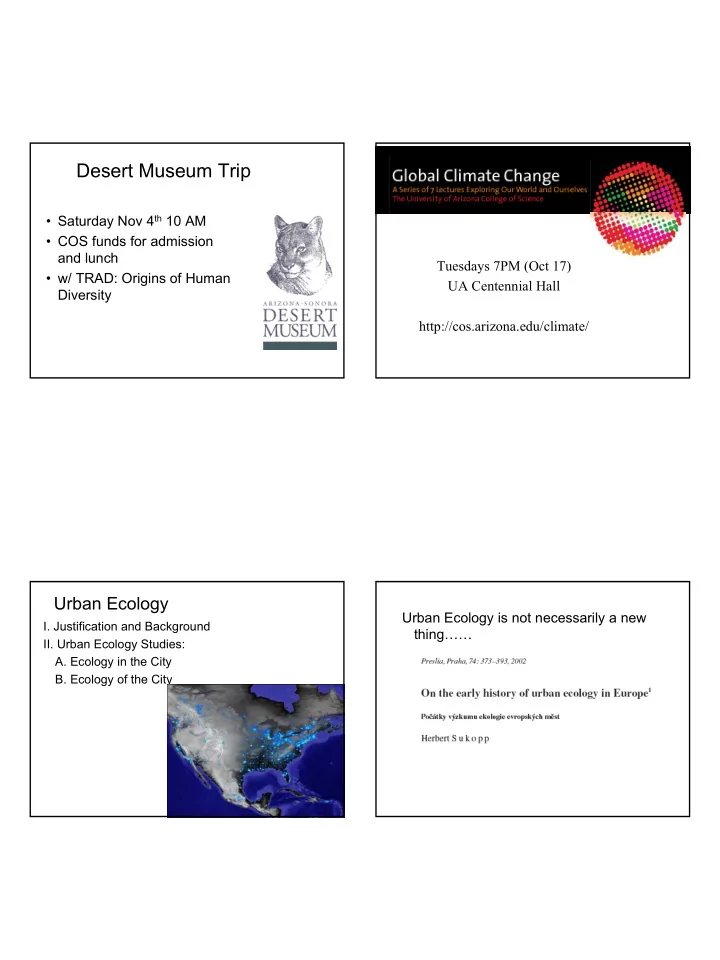

Desert Museum Trip • Saturday Nov 4 th 10 AM • COS funds for admission and lunch Tuesdays 7PM (Oct 17) • w/ TRAD: Origins of Human UA Centennial Hall Diversity http://cos.arizona.edu/climate/ Urban Ecology Urban Ecology is not necessarily a new I. Justification and Background thing…… II. Urban Ecology Studies: A. Ecology in the City B. Ecology of the City 1
Recent Conceptual Advances Ecology and the Role of Humans • Ecosystem Ecology – humans are components of ecosystems Tansley 1935 “We cannot confine ourselves to the so called ’natural’ entities and ignore the processes and expressions of vegetation now so abundantly provided by man.” • Conservation Biology – focus in places where people live and work Odum 1969 “….an ecology that considers humans as a part of , not apart from, nature” Vitousek 1997 “Most aspects of the structure and functioning of the earth’s ecosystems cannot be understood without • Environmental Ethics – what is wild? blindspot to accounting for the strong, often dominant influence of humans in envi.philosophy humanity” United States Urban Population Urban Non-urban 100% 80% Population 60% 40% 20% 0% 1980 2025 YEAR from United Nations, 1996 2
Urban areas impact the environment through: 1) Alterations in hydrology 2) Inputs of pollutants 3) Modification of local climate 4) Landscape fragmentation 5) Habitat transformation 6) Species introductions Approaches to Urban Ecology: Tucson Bird Count Ecology in the City Hummingbird Project Ecological structure and function of • Lower native bird diversity habitats or organisms in the city • Overall diversity increases • A few natives do well in town (Thrasher, Focus on the physical environment, soils, WW Dove) plants and vegetation, and animals and • Many natives are rarely found in town wildlife www.tucsonbirds.org http://hummingbirds.arizona.edu/ 3
Cultural Coevolution Cultural Coevolution Humans Environment Selection Genes Culture Genes Culture Selection Inheritance Inheritance Time Genes Culture Genes Culture Foraging Innovations and Human Behavior The Gradient Paradigm - environmental variation is ordered in space - spatial environmental patterns govern the structure and function of ecological systems A Moisture G A B C D E F G Urban geography City Core Suburbs Rural Lands (Nihei and Higuchi 2001) 4
Asheville Asheville = Urban Site Nat’l = Suburban Site Forest 8 km 8 km = Rural Site Nutrient Cycling Nematodes Leaf Litter N-Mineralization Decomposition 5
(A) (B) (C) Implications Aspects of Biotic and Ecosystem Urbanization Environmental Effects Effects Ecosystem ‘remnants’ don’t necessarily function the same as non-urban Drier Soil Increased Slower Decomp Warmer Soil counterparts Density Faster N-Min Less SOM Urbanization reduces soil quality � ecosystem health/sustainability ? Shift in Nematode Community Population Frequency of United Urban Environments Differ States Cities pH Annual Temperature 700 6 600 14 5 12 Asheville 500 4 10 Frequency Baltimore 8 3 400 6 2 4 300 1 2 New York 0 0 200 NYC BALT Asheville NYC BALT Asheville 100 Rural Urban 0 100 10 - 24 25 - 49 50 - 99 100 - 199 200 - 399 400 - 799 800 - 1599 1600 - 3199 3200 - 6399 6400 - 12799 80 60 40 20 0 City Size Class (x 1000 people) NYC BALT Asheville Soil Organic Matter 6
Comparative Density Urban Asheville Tucson Compact Ecology # Baltimore Phoenix New York Information Size Small Large City Size City Size Economy Industrial Environmental Impact Environmental Impact Sprawling Ecosystem Health Ecosystem Health Approaches to Urban Ecology: Urban Nutrient Balance, Bangkok Ecology of the City Total nutrient inflow Systems oriented approaches to urban Population & ecology Income Area Atmospheric Deposition Food Total Food Supply Focus on dynamics of urban ecosystems, + Feed & fertilizer per capita -Local Production fluxes and flows, interactions River Collected Waste Accumulation 7
The City as an Ecosystem: LTER Approach Ecological Footprints (Rees and Wackernagel 1996) The Long-Term Ecological Research (LTER) Network Bear Brook, NH Vancouver, BC (http://www.lternet.edu) 1 m Central Arizona-Phoenix (CAP) Productive land area = 20,000 km 2 LTER (http://caplter.asu.edu) Baltimore Ecosystem Study (BES) LTER (http://www.beslter.org/) City = 114 km 2 0.31 m Long-term: 200 point survey CAP LTER – data mining Construction of an ecosystem N budget Data: 1) 7-8x higher inputs • Photos 2) 90% of these are human mediated • Weather • Built envt Desert Ecosystem CAP Ecosystem • Cover • Soil • Vegetation • Birds and bugs • Human activity surveys 8
Trends in air temperature in CAP and Baltimore CAP Ecosystem: Baltimore Ecosystem: Steady increase since 1950 Peak in 1950’s Days can be cooler in city Days warmer in city Impacts of a warm Phoenix Phoenix – Heat Island (~3.1 ºC since 1950) • Misery hours – 30 deaths/y (13x national average) – Irritability, aggression (~7% of violent crimes in 1998!) • Heating and cooling – 16-30 % rise in energy consumption • Longer arthropod ‘thermal window’ – More disease vectors? Ag pests? 9
Human Ecosystem Model for Urban Ecosystems 10
Recommend
More recommend